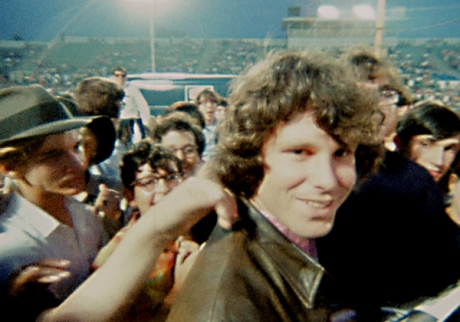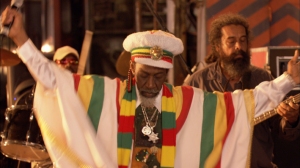When You’re Strange: A Film About The Doors
December 29, 2010
In a time where everything appears to have a price tag, writer/director Tom Dicillo’s statement rings true; “The Doors, they never sold out. It was deeply inspirational to be reminded that not everything is for sale.” More than just a documentary about the formation of an iconic band, When You’re Strange: A Film About The Doors (2009), is about that historical, social and political synthesis that occurs when music engages with and permeates its temporal context.
Whilst it is undoubtedly true that the music itself stands strong “against time” (so to speak), it is also true that The Doors are a band, and that their music is an output, that captures something significant of its own time. Perhaps the very reason it resonates still today is that what it captured was a transient and hopeful moment never fully realised; its relevancy today, therefore, permeating and immovable.
Refreshingly for a documentary about so famous a group as The Doors, Dicillo doesn’t go down the tired and frankly rather fruitless line of “talking heads” and instead uses fine filmmaking craft to find the most piercing way to start a story: “The sixties began with a shot.” Tracing from here the events and awakenings of the time, Dicillo moves from the assassination of John F. Kennedy through the Civil Rights Movement and up to the Vietnam War. Commenting upon whilst chartering these significant events, When You’re Strange is as much about historically significant values and moments of cultural change as it is the band. Dicillo doesn’t just pose history as a backdrop for their advent to fame but rather as the symbiotic, organic relationship that evolved between the two; “The establishment exists but a genuine counter-culture is growing.”
Making full use of remarkable stock footage of the band playing gigs as well of their fans and contemporaries, When You’re Strange is told simultaneously through voice-over narration and musical progression. A surprisingly rare feat for a music documentary, When You’re Strange actually considers the quality and aspects of their music and why that was not only unique but how it engaged and informed their displays of revelry and the carnivalesque in relation to the emerging counter-culture of the time. There is of course a tendency towards focus on Jim Morrison above other members of the band, but at no time does the film ignore the other three members; John Densmore, Robby Krieger, Ray Manzarek; in preference of the notorious front man, always ensuring the focus is in relation to his effect on the group as a whole.
Contemplating violence as an American tradition and with the advent of Richard Nixon to the presidency, the film culminates in an extraordinarily moving montage set to “Riders on the Storm”. Contrasting war footage and an all-American child on the home front swinging like a monkey set perfectly to the lyric “let your children play”, When You’re Strange highlights how mimicry can lead to devastation. Revealing how political unrest ebbs and flows between counter-culture and conservatism just as artistic expression moves between its own motivating forces, When You’re Strange is never over dramatised or condescending to its audience and allows the incredible imagery and music of its subject to do so much of “the talking”. That said, the film is still scripted and operates as an “informative” documentary in the first instance, the dulcet tones of Johnny Depp narrating and guiding the experience. A fantastic documentary that reveals compelling subject matter, this is certainly one to make time for.
When You’re Strange: A Film About the Doors is screening exclusively as part of an ACMI’s long-play season from December 27 2010 to January 3 2011 and is distributed through Madman Entertainment.
Written by Tara Judah for Liminal Vision.
An Education
March 4, 2010
Gerald Levy, a Jamaican dancehall sensation more commonly known as ‘Bogle’ (a name taken from Jamaican national hero Paul Bogle), was murdered in a motorcycle drive-by at a gas station on January 20 2005. His untimely death was most likely the result of tall poppy syndrome; his creative rivals John Hype and Bruce Golding thought to be the killers.
This is the backdrop against which the history and current climate of both reggae and dancehall music are set in Jerome Laperrousaz’s brilliant documentary Made in Jamaica (2006). Infinitely more than just a bit of bump’n’grind, Made in Jamaica examines a continued history of oppression and resistance as experienced through musical and lyrical revolution. Exploring the origins of both the music and the people who make it, Made in Jamaica considers everyone involved, from Bob Marley to Elephant Man who describes Levy’s murder as “a breakdown for Jamaica and the world”. Laperrousaz introduces one hero to the movement after another, including; Lady Saw, Bunny Wailer, Gregory Isaacs, Bounty Killer, Third World, Capleton, Toots and Tanya Stephens. Through their vocal militancy the spirit of resistance and a hope for freedom overwhelmingly resounds.
It is Elephant Man who explains the real meaning of the music in relation to its origins in Jamaican ghettos, describing it as a “saviour” for living persistently with ambition but no money. The experiences shared by Bounty Killer and Lady Saw reiterate strongly the tiresomeness and frustration that comes with being born into poverty, but it is this same frustration that lead their clear path to fame and fortune. The struggle however is in no uncertain terms over. Third World are resolute in their commitment to the continued fight for freedom, “We don’t have total control… but we have made some progress”, their insistence upon the absolute importance of making music with a message, something Tanya Stephens certainly shares in her own lyrical struggle against the oppression of women in Jamaica who undeniably suffer more than their male counterparts. But no one’s understanding of the gravity of the continual struggle that ensues is sounder than Bunny Wailer’s, his assertion that the chains of slavery have merely been replaced by metal guns sat all too comfortably upon the hips of a generation of hungry Jamaicans, “A hungry man is an angry man. You can’t put guns in the hands of a hungry man, because if everybody have guns and no food, then you’ve got to bite the bullet.”
Both vehement and eloquent in its forward trajectory, the musical revolution continues to impress upon new generations the importance of educating, emancipating and re-educating themselves to continually build upon the successes of their forefathers. So recent as August 1962, the moment of Independence still tastes bittersweet, for many revolution is not yet won. Capleton knows as well as Bunny Wailer that the new struggle presents itself through slavery of a different kind: mental slavery, something that only an individual can free him/herself from, “Only the Fire they can’t take from us. The Fire burns from within.” And it is from within that the power and passion expressed through music and dancing starts, spreading far and wide beyond the confines of Kingston and Trench Town into the farthest places in the world, strong and determined.
An absorbing and affecting documentary regardless of your attitudes to reggae and dancehall music, Made in Jamaica is more than a colourful vision of a nation and a culture, ultimately, it’s an education.
Made in Jamaica is released on DVD March 8th 2010 through Network Releasing.



